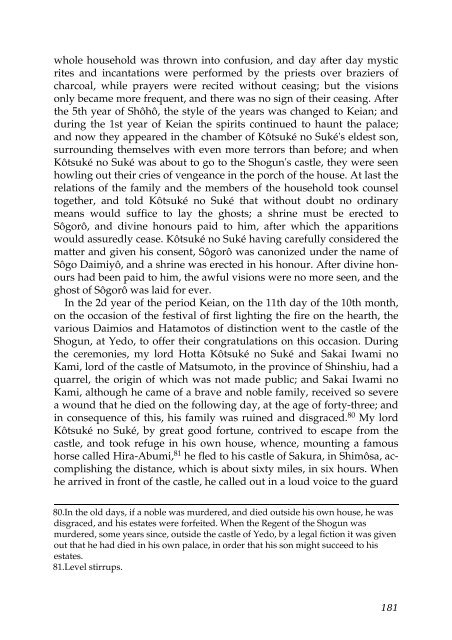Create successful ePaper yourself
Turn your PDF publications into a flip-book with our unique Google optimized e-Paper software.
whole household was thrown into confusion, and day after day mystic<br />
rites and incantations were performed by the priests over braziers <strong>of</strong><br />
charcoal, while prayers were recited without ceasing; but the visions<br />
only became more frequent, and there was no sign <strong>of</strong> their ceasing. After<br />
the 5th year <strong>of</strong> Shôhô, the style <strong>of</strong> the years was changed to Keian; and<br />
during the 1st year <strong>of</strong> Keian the spirits continued to haunt the palace;<br />
and now they appeared in the chamber <strong>of</strong> Kôtsuké no Suké's eldest son,<br />
surrounding themselves with even more terrors than before; and when<br />
Kôtsuké no Suké was about to go to the Shogun's castle, they were seen<br />
howling out their cries <strong>of</strong> vengeance in the porch <strong>of</strong> the house. At last the<br />
relations <strong>of</strong> the family and the members <strong>of</strong> the household took counsel<br />
together, and told Kôtsuké no Suké that without doubt no ordinary<br />
means would suffice to lay the ghosts; a shrine must be erected to<br />
Sôgorô, and divine honours paid to him, after which the apparitions<br />
would assuredly cease. Kôtsuké no Suké having carefully considered the<br />
matter and given his consent, Sôgorô was canonized under the name <strong>of</strong><br />
Sôgo Daimiyô, and a shrine was erected in his honour. After divine honours<br />
had been paid to him, the awful visions were no more seen, and the<br />
ghost <strong>of</strong> Sôgorô was laid for ever.<br />
In the 2d year <strong>of</strong> the period Keian, on the 11th day <strong>of</strong> the 10th month,<br />
on the occasion <strong>of</strong> the festival <strong>of</strong> first lighting the fire on the hearth, the<br />
various Daimios and Hatamotos <strong>of</strong> distinction went to the castle <strong>of</strong> the<br />
Shogun, at Yedo, to <strong>of</strong>fer their congratulations on this occasion. During<br />
the ceremonies, my lord Hotta Kôtsuké no Suké and Sakai Iwami no<br />
Kami, lord <strong>of</strong> the castle <strong>of</strong> Matsumoto, in the province <strong>of</strong> Shinshiu, had a<br />
quarrel, the origin <strong>of</strong> which was not made public; and Sakai Iwami no<br />
Kami, although he came <strong>of</strong> a brave and noble family, received so severe<br />
a wound that he died on the following day, at the age <strong>of</strong> forty-three; and<br />
in consequence <strong>of</strong> this, his family was ruined and disgraced. 80 My lord<br />
Kôtsuké no Suké, by great good fortune, contrived to escape from the<br />
castle, and took refuge in his own house, whence, mounting a famous<br />
horse called Hira-Abumi, 81 he fled to his castle <strong>of</strong> Sakura, in Shimôsa, accomplishing<br />
the distance, which is about sixty miles, in six hours. When<br />
he arrived in front <strong>of</strong> the castle, he called out in a loud voice to the guard<br />
80.In the old days, if a noble was murdered, and died outside his own house, he was<br />
disgraced, and his estates were forfeited. When the Regent <strong>of</strong> the Shogun was<br />
murdered, some years since, outside the castle <strong>of</strong> Yedo, by a legal fiction it was given<br />
out that he had died in his own palace, in order that his son might succeed to his<br />
estates.<br />
81.Level stirrups.<br />
181



